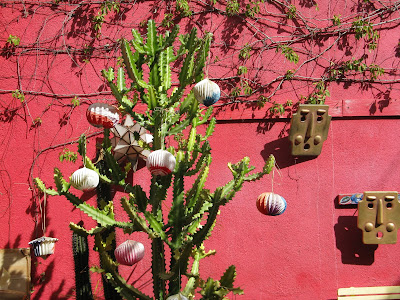


 After several days exploring the lovely and oftentimes noisy streets of La Paz, Jane and I rented a car to check out the small but growing town of Todos Santos, lying an hour south and just a mile or two shy of the Pacific shore of the Baja peninsula (for those unfamiliar with Baja geography, La Paz is situated on the Sea of Cortez). Driving in Mexico will never be my favorite activity on earth - as soon as I had finally gotten accustomed to motorists blowing through stop signs, I had to deal with motorists passing on hills over solid yellow lines. But the endless stretches of pristine desert and the distant vistas of the magnificant Sierras de la Laguna make up for any white-knuckle moments.
After several days exploring the lovely and oftentimes noisy streets of La Paz, Jane and I rented a car to check out the small but growing town of Todos Santos, lying an hour south and just a mile or two shy of the Pacific shore of the Baja peninsula (for those unfamiliar with Baja geography, La Paz is situated on the Sea of Cortez). Driving in Mexico will never be my favorite activity on earth - as soon as I had finally gotten accustomed to motorists blowing through stop signs, I had to deal with motorists passing on hills over solid yellow lines. But the endless stretches of pristine desert and the distant vistas of the magnificant Sierras de la Laguna make up for any white-knuckle moments.Todos Santos is a city in flux. With 6,000 inhabitants and a sleepy atmosphere, the city has recently become a draw for American expats, especially artists and organic farmers. The galleries and art halls in Todos Santos are open and full of light, and suggest what Taos or Santa Fe must have been like a few generations ago. Yet the town hasn't been totally destroyed by gringos, despite large numbers of tourists sporting crocs and bad hats. I sensed an uneasy jostling between long-time locals and newly-arrived Americans, and the multiple offices devoted to hawking coastal Baja real estate was truly disheartening (lots are going for $300,000, quite a deal compared to north of the border, but a stunning increase from the $30,000 lots of just five years ago). We enjoyed wonderful carne asada tacos and tortas pollo at a tiny taqueria along a main drag before heading off in search of the legendary beaches of the southern Baja coast.
These beaches can be hard to locate, given the rough state of Baja roads and lack of signage. Still, after twenty-minutes of jostling down dusty rutted washes, we found ourselves along a high ridge of sand dunes and a long line of newly-erected beach homes boasting a wide array of architectural styles - from bauhaus to post-minimalist. There was no swimming here, despite the warm temperatures, as the drop-off was extreme and the waves ferocious. But walking along the completely empty and vast beach helped us forget the massive development wreaking so much havok on both the native cultures and environment of Baja California.
Later in the day, heading home in the dusk, Jane spotted the plumed-spray of migrating gray whales far off to sea. We'll have a few more days here in La Paz before we kayak to the remote and unsettled Isla Espiritu Santo, which a friendly chef last night told us was one of the last great untouched areas on the continent.











No comments:
Post a Comment